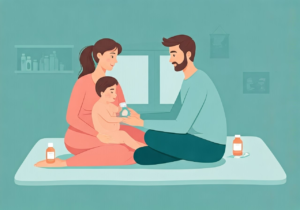If you’re having trouble conceiving, it’s important to get checked out by a doctor. There are many different treatment options available depending on your situation and what is causing the infertility.
If you’ve been trying for one year without success, then I highly recommend seeing your health care provider to discuss treatment options which can include fertility medication or insemination (artificial insemination or intrauterine insemination).
It’s important to remember that some of these treatments may not be covered by insurance so it might be wise to start investigating costs early on before starting any treatments.
We understand how expensive infertility treatment can become and we want our patients to know that they don’t have to go through this alone; we’re here for them every step of the way.

Fertility medication
If you’ve been trying to conceive for a year without success and if your partner is fertile, then we recommend starting with fertility medications. One option is Letrazole (Femara) which can stimulate ovulation when your body doesn’t produce enough follicle stimulating hormone.
This drug should be taken on an empty stomach in the morning because it has a high absorption rate that peaks two hours after ingesting the tablet. Some patients respond well to this treatment whereas others do not see any effect or get side effects such as hot flashes, night sweats, nausea, headaches, etc…
Therefore it may be necessary to take other drugs such as Lupron or Metrodin prior to starting Letrazole . Letrazole allows you to stimulate ovulation and therefore get pregnant faster compared to other medications which might require a procedure such as ovarian drilling.
Fertility injections
If Letrazole doesn’t work, then the next step would be fertility injections. After three months of trying without success on Letrazole , we might feel that it’s necessary to move onto injectable fertility drugs.
Pregnyl, Profasi or Pergonal are options for women who have been infertile for one year or more and if their partner is fertile. These fertility treatments should be performed in a doctor’s office because they require frequent blood tests and follow-up visits with your physician throughout treatment .
The advantage of these injections is that they only require once a day dosing compared to Letrazole which has to be taken twice a day.
Insemination
Infertility treatments can be broken down into two broad categories: those that help you get pregnant and those that help you stay pregnant . Insemination, also known as artificial insemination, falls under the first category.
The most common way of doing an intrauterine insemination (IUI) is during a woman’s natural ovulation cycle where sperm is placed directly inside the uterus by a physician using a flexible catheter. This procedure takes about 5 minutes and requires no anesthesia so it may seem simple but there are many steps involved such as scheduling around your menstrual cycle, blood work prior to treatment, etc…
There are other forms of insemination such as intrauterine tuboperitoneal insemination (IUTPI) and intracervical insemination (ICI), which can be done if you ovulate regularly but want to increase your chances of conceiving.

Intracervical insemination is performed by a physician and involves placing sperm inside the cervix using a soft catheter so it’s an option for those women who cannot have procedures such as IUI because they don’t produce any cervical mucous or if their cervical mucous is too thick.
Intrauterine tuboperitoneal insemination consists of mixing your partner’s sperm with fluid from your fallopian tube, flushing out the into your uterus through a catheter. This method is reserved for those patients who have fallopian tube blockage or other diseases that prevent sperm from reaching the egg.
Fertility surgery
Surgery is another option to restore fertility in some women and this can be done through laser surgery, ovarian drilling , ovarian cystectomy, etc… Laser surgery has been shown to help if you’ve been infertile for more than a year and your partner is fertile.
We use a hysteroscope to place the laser beam inside the uterus so we can see clearly what we’re doing and it’s performed with local anesthesia so there’s no need for general anesthesia .
One of the main reasons women choose this type of surgery is because it doesn’t require any external incisions or cuts; therefore there is less scarring and it’s a lot more cost effective.
Ovarian drilling
Another treatment option consists of ovarian drilling which entails putting several needle punctures into the ovary with an instrument that looks similar to a laparoscope, herein referred to as cautery .
A local anesthesia will be required for this procedure and each puncture site has to be cauterized so we can destroy certain egg follicles. This type of surgery is reserved for women who have tried IUI and artificial insemination unsuccessfully or those who do not produce cervical mucous which is needed for natural insemination.
If one of the fallopian tubes is blocked due to pelvic inflammatory disease (PID) this will also be an indication for this surgery.
In vitro fertilization
The most well-known fertility treatment is in vitro fertilization, or IVF . It’s a procedure where the egg is removed from the ovary and mixed with sperm in a laboratory dish to form embryos that are then transferred into your uterus.
The advantage of IVF is that it requires less medication than IUI or ovarian drilling treatments but it can be limited by how many eggs you produce per cycle. The cost of an IVF cycle can vary by clinic so you’ll need to ask about it before starting this treatment.

Another type of fertility medication is called gonadotropins , which are injected drugs derived from the hormone FSH (follicle-stimulating hormone). This medication stimulates your ovaries to produce more eggs and can be used for IUI or IVF treatments.
As with any other insulin-dependent medications, there’s a risk for developing diabetes or hyperthyroidism if stress is not minimized. Plus, the ovarian cysts associated with this treatment usually disappear after stopping it but sometimes surgery is required . Side effects during pregnancy are also possible as well as birth defects.
Gonadotropin releasing hormones are also used in fertility treatments to control the production of FSH in women who have polycystic ovarian syndrome, which is treated with birth control pills.
This type of treatment will increase the chances for multiple births so there are risks associated with it. You may also experience side effects when using this type of medication so be sure to discuss them properly before starting this type of therapy.
Fertility drugs are also reserved for patients who need help getting pregnant after having surgery on their fallopian tubes or prostate surgery because endometriosis can cause infertility .
Other therapies that induce ovulation include dinoprostone (Cervidil) which can be inserted into the vagina or endocervical canal about 6 days after period starts and then it’s removed 10 hours later or clomiphene citrate (Clomid) is usually prescribed as a pill starting on day 3 of your period and then you need to have intercourse 1-2 days before it can be effective.
After ovulation, the dominant follicle will release an egg which travels through one of the fallopian tubes towards the uterus. The uterine wall thins out to prepare for pregnancy but if there’s no implantation within 9 months, menstruation begins again.
IUI treatment
The first step involves taking fertility drugs to stimulate the ovaries to produce more eggs than usual which are then combined with sperm in a lab dish to form embryos.
These embryos are placed inside the uterus using a catheter about 36 hours after starting the fertility drugs. You should ask about the success rates of this treatment because it varies depending on factors such as age, amount of ovarian follicles and sperm count.
In a normal menstrual cycle, one egg is released from the ovary and it travels down towards the uterus. The lining of the uterus thickens in preparation for pregnancy but when implantation does not occur within 9 months, menstruation begins again.
Ovarian drilling is a surgical procedure where a small needle is used to make multiple holes in your ovaries which helps you get pregnant because it increases the number of available eggs.
Although ovarian tissue heals after this surgery, there’s still a risk that cysts will develop or that your body will become resistant to fertility drugs so only have this surgery if you’ve tried all other infertility therapies first.
If both fallopian tubes are blocked due to pelvic inflammatory disease (PID) or endometriosis, in vitro fertilization or IVF is recommended. During this treatment, embryos are formed using donor sperm and eggs in a lab and then they’re placed inside the uterus about 3-5 days after ovulation.
If successful, this type of fertility treatment can help you get pregnant but there’s also a risk for multiple births because more than one embryo is usually transferred to your uterus.
IVF/ICSI (in vitro fertilization)
Before starting IVF, make sure you discuss all its benefits and risks with your doctor such as multiple births, ectopic pregnancy or even failure to get pregnant.
Your age will be taken into consideration when deciding how many embryos should be transferred so talk about it thoroughly before starting this procedure.
The success rates for this treatment vary depending on the patient’s age, ovarian reserve and whether a single or double embryo transfer is performed.
In vitro fertilization is a process where the egg and sperm are joined together in the lab to form embryos that are then placed into your uterus.
The main benefit of IVF treatments is that you can be sure that any child conceived has no chromosome abnormalities but there’s also a risk for ectopic pregnancy , multiple births and intense emotional stress due to high failure rates during these procedures.
In addition, it requires very close monitoring while taking fertility drugs so make sure you discuss all other benefits and risks with your doctor before going through with this type of therapy.
Since polycystic ovarian syndrome decreases your chances of getting pregnant, you can ask your doctor about fertility drugs. The most commonly prescribed ones are clomiphene citrate (Clomid) or letrozole (Femara).
The success rates for this treatment vary depending on whether one or several cycles are used before giving up.
Egg freezing allows women to preserve their fertility by extracting and fertilizing eggs in the lab before they’re frozen for future use with IVF methods.
This procedure is only recommended if you plan to have children later in life after completing your education or having established yourself professionally because it doesn’t protect against genetic diseases that could affect a baby conceived through ICSI.
It’s usually done under local anesthesia but implantation rates are not high so you’re more likely to become pregnant if you freeze eggs during your early 30’s.
Many women are concerned about their fertility or want to have children at a later age so these procedures are good options for preserving their fertility until they’re ready to conceive.
However, make sure you discuss all the risks and benefits of each method with your doctor before undergoing any type of fertility treatment because it can also be expensive depending on your health insurance coverage.
Trying to conceive naturally is the best way to get pregnant but it requires finding out the underlying cause of infertility. Your doctor will do a thorough exam and perform blood tests, take an ultrasound or carry out hysteroscopy before recommending any type of fertility treatment .
For instance, if your ovaries don’t produce enough estrogen, you’ll need to take medications that contain this hormone for several months before starting treatments such as IUI or IVF that increase the chances of getting pregnant.
Another example is if you have endometriosis or blocked fallopian tubes then surgery might be needed first before trying other infertility therapies.
In conclusion, there are three main options available for women who want to get pregnant either by preserving their fertility first or after completing their education or professional success.
IVF is the best option for women with polycystic ovarian syndrome because it increases the chances of becoming pregnant but it has potential complications such as multiple births and ectopic pregnancy.
A woman’s age will also be taken into consideration when deciding how many embryos to transfer during an IVF procedure so make sure you discuss all benefits and risks with your doctor first before undergoing this type of treatment .
Egg freezing is another viable method after discussing its benefits and risks with your doctor. It allows you to preserve your fertility until you’re ready to conceive but implantation rates are low so more than one cycle might be needed before getting pregnant through this treatment option.
The success rate depends on a woman’s age at the time she freezes her eggs so it’s important to have this discussion with your doctor first before undergoing any procedure.
On the other hand, fertility drugs are more affordable but they’re not ideal for every woman. They can only be used under close monitoring of your doctor because of potential risks such as high blood pressure or ovarian hyperstimulation syndrome that could lead to hospitalization.
However, these medications increase the chances of getting pregnant especially for women with polycystic ovary syndrome who want to preserve their fertility.
If you’re looking for an alternative to expensive fertility treatments then talking about your options with your doctor is the best way to get started.
He will discuss any risks and benefits depending on your health history before giving you advice on how to get pregnant either naturally or after completing your education or professional success.
Women can also talk with their doctors in more detail about specific procedures based on their needs so make sure you consult your doctor first before trying any of these methods because they aren’t recommended for everyone depending on age, current health status, presence of diseases in the reproductive organs, etc.
Conclusion paragraph
Achieving pregnancy can be difficult without help. If you’re one of the many women who are struggling to conceive, it’s time for you to take action and see your health care provider as soon as possible.
Knowing that there is a treatment option available may make things easier on both yourself and your partner – but no matter what course of action you choose, remember not to give up hope!
You will eventually get pregnant if you keep trying (even after 1 year). Trust me; I’ve been through infertility and know how hard it can be. With patience and perseverance, we’ll find our way back into motherhood together again! Stay tuned for more blog posts about fertility treatments in the future.



